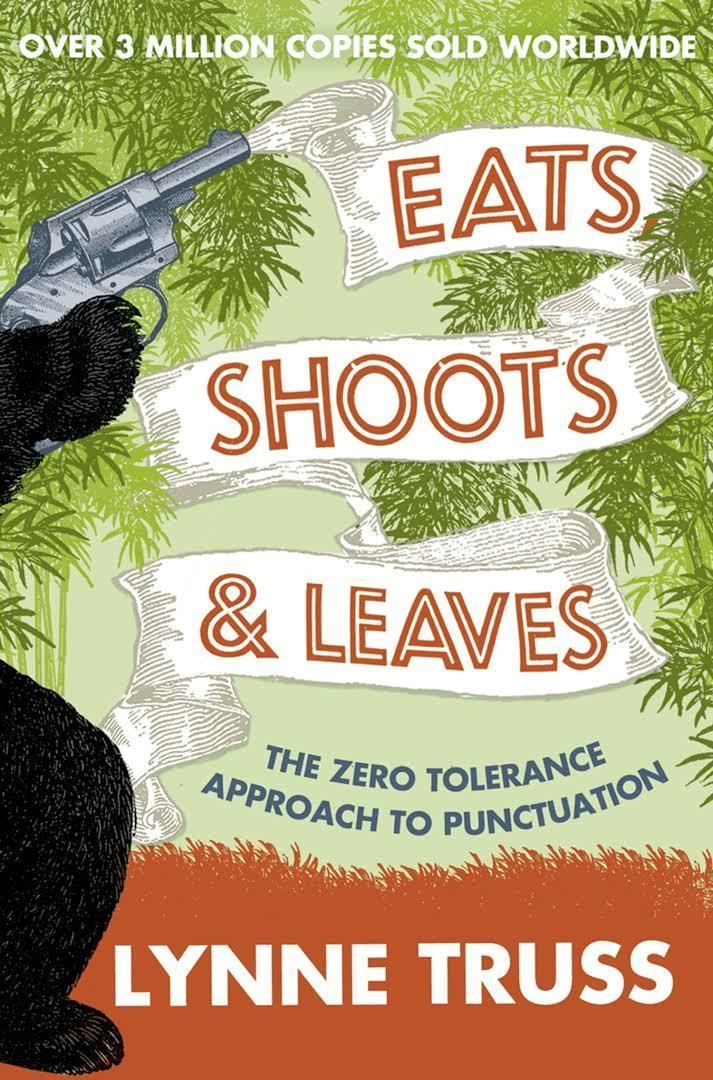7.8 /10 1 Votes7.8
Country United Kingdom Media type Print (hardcover) ISBN 978-1-86197-612-3 Originally published 6 November 2003 Genre Non-fiction | 3.9/5 Goodreads Publication date 6 November 2003 Pages 228 pp. OCLC 55019487 Illustrator Bonnie Timmons | |||||||||||||||||||||||||||||||||
 | ||||||||||||||||||||||||||||||||||
Similar Lynne Truss books, Non-fiction books, English language books | ||||||||||||||||||||||||||||||||||
Eats, Shoots & Leaves: The Zero Tolerance Approach to Punctuation is a non-fiction book written by Lynne Truss, the former host of BBC Radio 4's Cutting a Dash programme. In the book, published in 2003, Truss bemoans the state of punctuation in the United Kingdom and the United States and describes how rules are being relaxed in today's society. Her goal is to remind readers of the importance of punctuation in the English language by mixing humour and instruction.
Contents
Truss dedicates the book "to the memory of the striking Bolshevik printers of St. Petersburg who, in 1905, demanded to be paid the same rate for punctuation marks as for letters, and thereby directly precipitated the first Russian Revolution"; she added this dedication as an afterthought after finding the factoid in a speech from a librarian.
Overview
There is one chapter each on apostrophes and on commas, one on semicolons and colons, one on exclamation marks, question marks, and quotation marks, italic type, dashes, brackets, ellipses, emoticons and one on hyphens. Truss touches on varied aspects of the history of punctuation and includes many anecdotes, which add another dimension to her explanations of grammar. In the book's final chapter, she opines on the importance of maintaining punctuation rules and addresses the damaging effects of email and the Internet on punctuation.
Irish American author Frank McCourt, author of Angela's Ashes, wrote the foreword to the U.S. edition of Eats, Shoots & Leaves. In keeping with the general lighthearted tone of the book, he praises Truss for bringing life back into the art of punctuation, adding, "If Lynne Truss were Roman Catholic I'd nominate her for sainthood."
The book was a commercial success. In 2004, the U.S. edition became a New York Times bestseller. Contrary to usual publishing practice, the US edition of the book left the original British conventions intact.
Title
The title of the book is a syntactic ambiguity—
A panda walks into a café. He orders a sandwich, eats it, then draws a gun and proceeds to fire it at the other patrons.
"Why?" asks the confused, surviving waiter amidst the carnage, as the panda makes towards the exit. The panda produces a badly punctuated wildlife manual and tosses it over his shoulder.
"Well, I'm a panda," he says. "Look it up."
The waiter turns to the relevant entry in the manual and, sure enough, finds an explanation. "Panda. Large black-and-white bear-like mammal, native to China. Eats, shoots and leaves."
Criticism
In a 2004 review, Louis Menand of The New Yorker pointed out several dozen punctuation errors in the book, including one in the dedication, and wrote that "an Englishwoman lecturing Americans on semicolons is a little like an American lecturing the French on sauces. Some of Truss's departures from punctuation norms are just British laxness."
In The Fight for English: How Language Pundits Ate, Shot and Left (Oxford University Press 2006), linguist David Crystal analyses the linguistic purism of Truss and other writers through the ages.
In 2006, English lecturer Nicholas Waters released Eats, Roots & Leaves, criticising the "grammar fascists" who "want to stop the language moving into the 21st century." This view was shared by dyslexic English comedian and satirist Marcus Brigstocke in a 2007 episode of Room 101, in which he blames Truss's book for starting off a trend in which people have become "grammar bullies," who are later put into Room 101.
Editions
In July 2006, Putnam Juvenile published a 32-page follow-up for children entitled Eats, Shoots & Leaves: Why, Commas Really Do Make a Difference! Based on the same concept, this version covers only the section on comma usage and uses cartoons to explain the problems presented by their poor usage.
